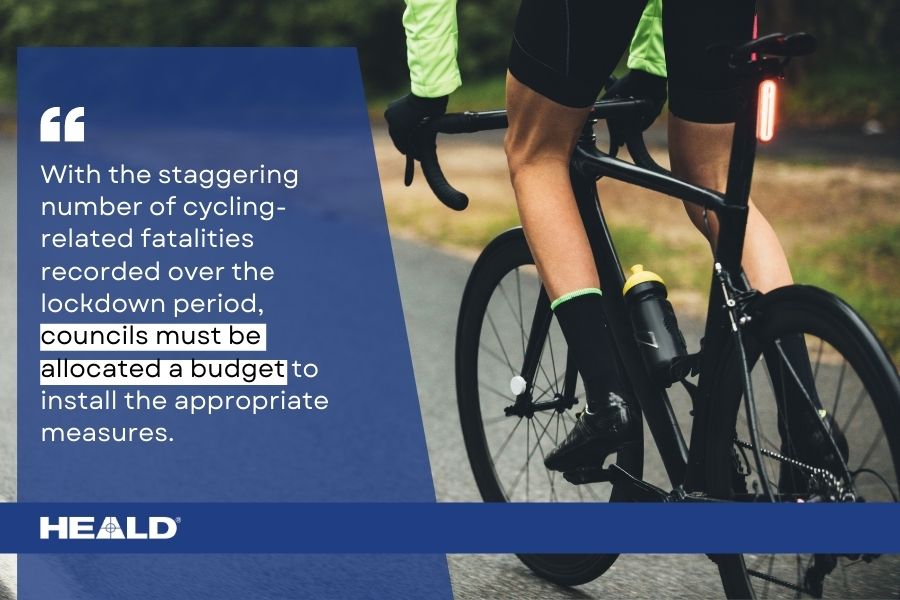Need to speak to us? Here’s our most useful number and email addresses
Sales: sales@heald.uk.com
General information: info@heald.uk.com
Marketing: marketing@heald.uk.com
Need to speak to us? Here’s our most useful number and email addresses
Sales: sales@heald.uk.com
General information: info@heald.uk.com
Marketing: marketing@heald.uk.com

The pandemic has changed how many people view exercise, leading to an increase in home gyms, fitness subscriptions, and swapping driving into work for cycling. In light of this and the government’s cycling to work scheme, we’ve delved into how many UK towns and cities have sufficient barriers in place to protect cyclists from road collisions.
Following a 500% increase in sales for cycling equipment at the start of the first national lockdown¹, and the UK government encouraging cycling as a means of eco-conscious travel, our new study delves into the number of temporary and permanent barriers UK councils have in place to protect cyclists from road collisions.
The findings are based on insight obtained by us through Freedom of Information requests (FOIs) sent to 360 UK councils². From councils having no barriers in place to protect cyclists to councils not planning on spending any budget on cyclist protection, below we breakdown the key findings from the council FOI responses we were able to obtain:
Permanent Barriers
Out of the 360 councils contacted, 149 responded, and out of these 149 councils, only Darlington Council and Brent Council revealed they have permanent barriers in place to protect cyclists.
A staggering 99% of councils that responded to our request for information are not aware of any barriers or bollards in place to protect cyclists from road collisions. Considering the cycle to work scheme and the government’s most recent climate change pledge, which encourages cycling into work, it’s clear that the government needs to provide councils with the budget to implement the appropriate cycling measures to ensure UK residents can fulfil their eco-friendly transport efforts safely.
Temporary Barriers
Our new study also revealed that 149 of the councils that responded to the FOI request have no temporary barriers in place for cyclists. Following reports of cyclists’ death doubling during lockdown compared to the previous year³, these statistics reaffirm the need for councils and the government to consider implementing appropriate cycling infrastructure right across the UK.
Planned Cycling Infrastructure Spend
According to our insight, only 13 councils planned to spend on measures to protect cyclists, with Nottingham City Council planning to spend the most, with a figure of £38m. This follows £2bn worth of funding from the government to improve cycling infrastructure on UK roads?. However, this means 91% of the councils that responded to the FOI request were unaware of any cyclist protection being implemented within their area, regardless of the government funding. With 66% of adults in England stating that the roads feel too dangerous to cycle on?, this highlights a clear need for cycling protection on UK roads.
The following UK councils were able to share insight into their planned spend on cycling infrastructure?:
Cycling Fatalities
Out of the 149 councils that shared information, 12% recorded cycling deaths between January 1st, 2019 and January 1st 2020. During this period, Essex County Council recorded the highest number of cycling fatalities, with eight cyclists dying in a road collision during this time.
According to a report, one fatality between these 12 months included Freddie Oborne, an 80-year-old cyclist and triathlete killed in Hatfield, Hertfordshire. A 23-year-old woman from Hertford was arrested at the scene on suspicion of causing death by dangerous driving?.
The following UK councils were able to share insight into cycling-related fatalities in their area?:
Perimeter Protection
For pedestrian and cyclist protection, the Apex Static Bollard and the Synergy Bollard would enable a simple and fast installation. Both have been IWA tested to ensure the bollards meet industry standards.
Apex Bollard
The Apex bollard was tested in an array of 3 bollards, with the vehicle impacting perpendicular to a single bollard to offer maximum protection. The modular design means that the bollard line can be extended to provide protection along the full perimeter. The bollards are simply positioned with no pinning required and then secured in place with a concrete backfill, and therefore would make the perfect option for councils to create a secure network of cycling routes on UK roads.
Synergy Bollard System
The Synergy was initially brought to market to address the challenges faced by retrofitting HVM measures on bridges in light of a number of high profile attacks on London bridges but is suitable for securing a variety of inner-city locations including footways and cycle lanes.
Taking just 45 minutes to deploy, excluding civilians, the revolutionary product consists of nine fixed bollards on individual baseplates, which are bolted together. It is a completely unique product that requires no pinning. The product has been crash tested with an array of nine interconnected bollards, with the design allowing for additional bollards to be added to expand the area being protected.
Patent applied technology offers additional protection by anchoring the bollards into the ground upon impact, preventing the vehicle from penetrating the area the bollards are protecting.
Summary
It’s devastating to see how the pandemic has impacted the number of cycling deaths in the UK, but with the limited barriers and bollards in place to protect cyclists from collisions, it’s sadly not a surprise. With the government encouraging cycling as a way of contributing to a greener UK, councils would benefit from the funds to implement systems to protect cyclists and vehicles from road collisions as it would encourage more people to get involved with the activity.
Installing bollards would be the ideal solution for councils to ensure proper cyclist protection on UK roads and would mean an increase in confidence on the roads. With the staggering number of cycling-related fatalities recorded over the lockdown period, and with the government pushing the UK to travel more sustainably, councils must be allocated a budget to install the appropriate measures.
There has been huge groundwork put in across the manufacturing and security industry to develop products that can help improve the safety of the public and it’s important that the government, councils and other authorities consider making use of these.
Sources

